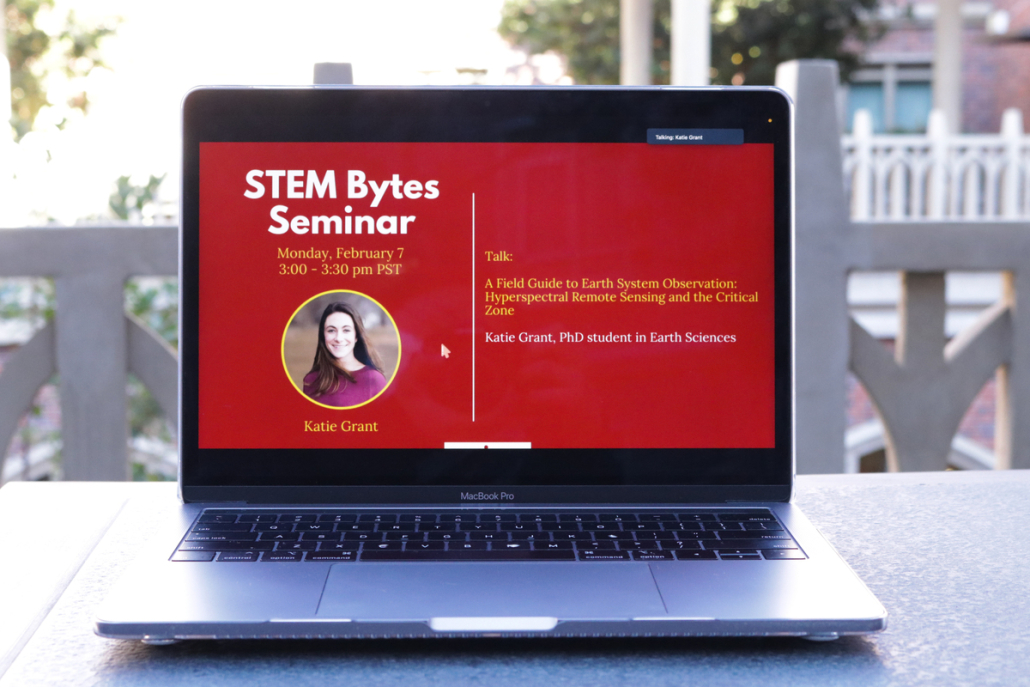PhD student shares research on imaging

When Katie Grant was younger, she recalls driving past the NASA Ames Research Center and wanting to know how she could end up working there. Now a graduate student intern at the NASA Jet Propulsion Laboratory and a doctoral student studying earth sciences, Grant discussed the benefits of bridging imaging spectroscopy and biogeochemistry in Earth system observations and scaling Earth’s terrain in her webinar, “A Field Guide to Earth System Observation: Hyperspectral Remote Sensing and the Critical Zone” Monday.
In the presentation hosted by the STEM Bytes Seminar and moderated by the Women in Science and Engineering program, Grant explained Earth system observations, a composition of research that uses geological and atmospheric data to analyze the effects of climate change on different environments. Grant said the Earth system observation of the Earth’s critical zone, an almost-surface level layer of the Earth’s crust that indicates the quality of essential resources — including food production and water — gives scientists the opportunity to observe, scale and classify large regions of land.
“That’s kind of the take-home benefit of my research,” said Grant in an interview with the Daily Trojan. “Challenges embedded in those benefits are spatially scaling ground truth data and imaging spectroscopy to say something about the larger region. I think we’ve come a very long way as the scientific community to overcome those challenges, yet they do still exist in some capacity.”
The presentation started with background information on remote sensing and the visible to shortwave infrared region of the electromagnetic spectrum. In practice, remote sensing reveals different cover types of the Earth’s surface — each with a unique spectral signature.
“We’ve barely begun to tap the surface and say something about the subsurface of the critical zone,” Grant said. “That’s really what I’m interested in doing is using hyperspectral data that’s remotely sensed data to say something about the subsurface.”

Marie Meneses, a marketing assistant for WiSE, helped moderate the event and invited attendees to ask questions about Grant’s presentation and personal journey through a Q&A session. Meneses said Grant has “a lot of advice and insight” to share.
WiSE Fellowship recipient Vanessa Rubien came to the presentation to support fellow women in STEM. She said that she “really resonated” with Grant’s experience driving past the Ames Research Center.
“To see her be able to achieve those goals through all of her experiences and her hard work was very inspiring,” said Rubien in an interview with the Daily Trojan.
Rubien, a doctoral student studying mechanical engineering, said she attends the STEM Bytes seminars to broaden her horizons and breadth of knowledge in various fields of STEM.
“I have no background with what she does. I’m on the aerospace and engineering side. She’s on the more ecological and biological side, so we’re like completely different ends,” Rubien said. “Her methodology and the databases that they use, there’s a little bit of overlap in that, so that was really cool to see somebody else doing work like that.”
Grant said Dana Chadwick, who Grant worked with at the Carnegie Institution for Science, served as her mentor and idol. Grant said she also praises Gregg Vane, the creator of the imaging spectrometer, for showing that science is also based on human connection.
“Who you have the pleasure of meeting, working with and engaging with all the way through really shapes not only the science but the work environment and so many more things,” Grant said.

Grant said her interest in being a speaker stemmed from wanting to connect with the younger generations of Earth scientists.
“I think I came in with the hope that maybe at least one person is interested in the work,” Grant said. “I’m hopefully initiating a conversation in that way and helping empower those students to chase these, or at least try this free area of research and see if they like it, and if they do, continuing helping them learn, grow and advance in their careers.”

